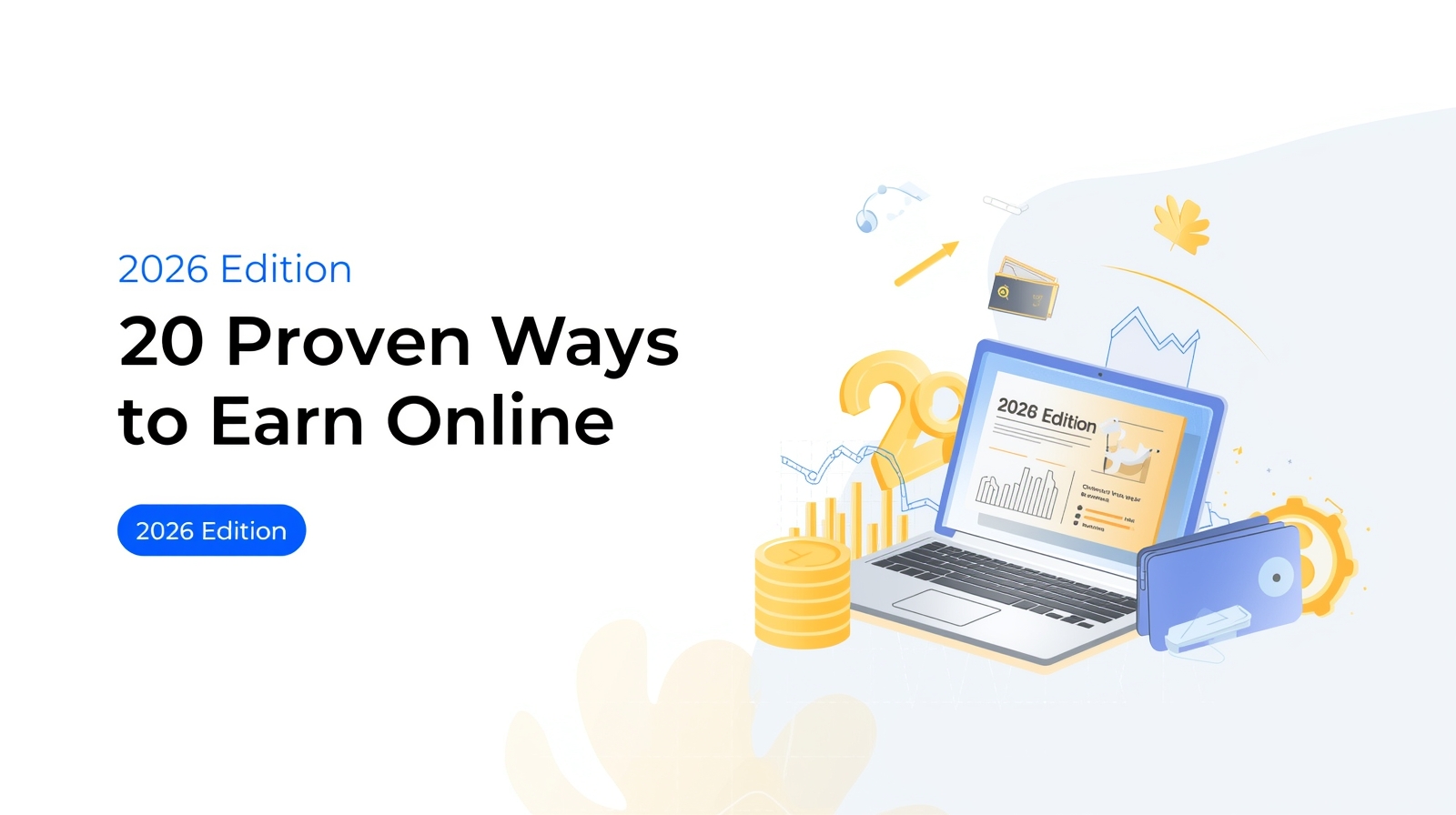1. Introduction — Why side hustles still matter in 2026
In 2026, the world keeps spinning and the cost of living keeps doing its own thing — usually going up. Side hustles aren’t a trend anymore; they’re a practical way to build income, learn new skills, and hedge against uncertainty. A good side hustle can be low-friction (start with what you already know), flexible (work from anywhere), and scalable (turn small wins into steady revenue). This article gives you 15 smart, realistic ideas you can start from home — no Silicon Valley venture capital required. Think of this as a friendly roadmap: pick one that fits your time, skills, and curiosity, then take small actions every day.
2. How to choose the right side hustle for you
Choosing a side hustle is less about chasing the hottest topic and more about matching three things:
- Skill fit — What can you do well (or learn quickly)?
- Time fit — How many hours per week can you realistically commit?
- Money fit — Do you want quick cash, or a longer-term build?
Quick checklist:
- List your top 5 skills.
- Note how many hours a week you can spare.
- Decide whether you want short-term income or long-term growth.
- Pick 2-3 side hustles from this article that match those items.
3. The 15 Smart Side Hustles
For each hustle below you’ll find: a short description, first steps, estimated income potential (range), essential tools, and pros/cons.
3.1. Freelance AI-assisted writing and editing
What it is: Writing blog posts, newsletters, product copy, or editing content using modern writing tools to increase speed.
How to start: Build a simple portfolio (3–5 samples). Offer 2–3 intro gigs on marketplaces (Upwork, Fiverr) or pitch small businesses. Use AI tools for drafts but always add your own voice and fact-checking.
Income potential: $200–$3,000+/month depending on clients and volume.
Tools: Google Docs, Grammarly, an AI writing assistant, a portfolio site (Carrd, Notion).
Pros: Low startup cost, high demand. Cons: Competitive; quality and reliability matter.
3.2. Niche content creation (micro-blogs, newsletters, and paid communities)
What it is: Create content focused on a narrow topic and monetize via paid subscribers (Substack, Revue), memberships, or sponsorships.
How to start: Pick a niche you love. Publish consistently for 8–12 weeks. Offer a free tier and a paid tier with exclusive content.
Income potential: $0–$5,000+/month (very wide — depends on niche and conversion).
Tools: Substack, Ghost, MailerLite, Patreon, Beacons.
Pros: Builds audience and long-term value. Cons: Slow at first; requires consistency.
3.3. Remote tutoring and micro-courses
What it is: Teach a skill one-on-one or through short online courses (think 30–120 minute focused modules).
How to start: Validate demand with a 1-hour paid workshop. Record short lessons and sell via Gumroad, Teachable, or Skillshare.
Income potential: $300–$6,000+/month.
Tools: Zoom, Loom, Teachable, Google Slides, Canva.
Pros: High margins, repeatable. Cons: Time-intensive if live.
3.4. No-code/low-code app building and marketplace sales
What it is: Build simple tools or templates (e.g., Airtable bases, Webflow sites, Glide apps) and sell them.
How to start: Identify a common pain point, build a template, list it on marketplaces (Gumroad, Makerpad, Webflow template marketplace).
Income potential: $100–$10,000+/month (templates can scale).
Tools: Glide, Adalo, Bubble, Airtable, Webflow.
Pros: Scalable; once built, sell repeatedly. Cons: Requires initial learning curve.
3.5. E‑commerce with print-on-demand and eco-friendly products
What it is: Sell physical goods without managing inventory using print-on-demand, or curate eco-friendly items with small-batch suppliers.
How to start: Choose a niche, set up Shopify + POD provider (Printful, Printify) or source from eco suppliers, and test with ads or organic content.
Income potential: $200–$8,000+/month.
Tools: Shopify, Etsy, Printful, Oberlo, Canva.
Pros: Low inventory risk. Cons: Thin margins; marketing required.
3.6. Reselling (sneaker flipping, vintage, or local finds)
What it is: Buy undervalued items locally or online and resell at higher prices.
How to start: Learn a niche (sneakers, vintage watches, collectibles), source from flea markets, thrift stores, or underpriced listings, then flip on eBay, StockX, or Depop.
Income potential: $100–$5,000+/month depending on skill.
Tools: eBay, StockX, Depop, authentication guides.
Pros: High margins if you know the market. Cons: Inventory risk; requires storage and authenticity knowledge.
3.7. Short-form video production for brands and influencers
What it is: Create TikToks, Reels, or YouTube Shorts for businesses who don’t have time to do it.
How to start: Make 3–5 sample videos, post them to your own profile, approach local businesses with a small sample package.
Income potential: $300–$6,000+/month.
Tools: CapCut, InShot, Premiere Rush, smartphone, a ring light.
Pros: High demand; visual portfolio grows fast. Cons: Trends change quickly; requires creative stamina.
3.8. Affiliate marketing with honest reviews and comparison sites
What it is: Recommend products and earn commissions through affiliate links — done well, it’s helpful content rather than spam.
How to start: Build a small site or niche blog, publish comparison posts, and join relevant affiliate programs.
Income potential: $50–$10,000+/month (high variance).
Tools: WordPress, Ahrefs/Free alternatives for keywords, affiliate networks (Amazon Associates, ShareASale, CJ).
Pros: Passive potential. Cons: SEO takes time; disclosure requirements.
3.9. Virtual assistance with niche specialization
What it is: Offer admin, customer support, content management, or systems support remotely — but specialize (e.g., podcast VA, Shopify VA).
How to start: Decide a niche, create a service page, and outreach to small businesses and creators.
Income potential: $300–$4,000+/month.
Tools: Trello/Asana, Zapier, Calendly, Gmail.
Pros: Recurring clients; stable income. Cons: Client management overhead.
3.10. Podcast production and monetization
What it is: Start a niche podcast or offer editing/production services to podcasters.
How to start: Record a pilot episode, set up hosting (Buzzsprout, Libsyn), and publish 6 consistent episodes.
Income potential: $0–$7,000+/month (sponsorships, memberships, consulting).
Tools: Audacity/Descript, Riverside.fm, Anchor, Otter.ai.
Pros: Builds trust and audience. Cons: Growing listeners takes time.
3.11. Micro SaaS (small subscription services solving specific problems)
What it is: Tiny web apps that do one thing well (e.g., invoice generator for a niche industry) with monthly fees.
How to start: Find a repetitive manual task people hate, validate with pre-sales, build an MVP (no-code or lightweight dev), charge $5–$50/month.
Income potential: $100–$20,000+/month depending on market fit.
Tools: Stripe, Bubble, Firebase, simple analytics.
Pros: Highly scalable. Cons: Requires maintenance and support.
3.12. Stock photography and AI-safe image licensing
What it is: Sell photos and original images where licensing policies remain generous — focus on unique, authentic niches (microstock, lifestyle, local landmarks).
How to start: Upload consistently to stock platforms, or set up a direct licensing page.
Income potential: $50–$2,000+/month.
Tools: Lightroom, a decent camera or smartphone, stock platforms (Adobe Stock, Shutterstock).
Pros: Passive income over time. Cons: Large libraries needed for meaningful income.
3.13. Technical gig work: automation scripts, Excel/Sheets consulting
What it is: Create scripts, templates, or automations for small businesses (Google Sheets automation, simple Python scripts, Zapier flows).
How to start: Build sample automations, list services on freelance sites, or pitch local businesses.
Income potential: $200–$6,000+/month.
Tools: Google Apps Script, Zapier, Make, Python basics.
Pros: High hourly value for niche skills. Cons: Can be technical; keep documentation.
3.14. Social media ad management for local businesses
What it is: Run small-budget Facebook/Instagram/YouTube ad campaigns for local clients.
How to start: Learn basics with a small ad budget, run experiments for your own promo, then pitch results to local businesses.

Income potential: $300–$8,000+/month (plus % of ad spend).
Tools: Facebook Ads Manager, Google Ads, analytics.
Pros: Businesses pay for results. Cons: Ad platforms change frequently; client ex


